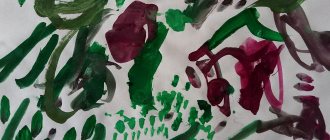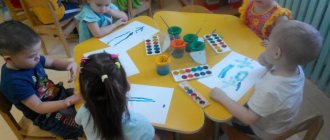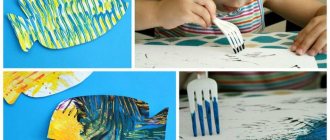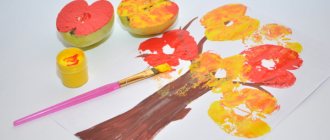The importance of fine motor skills for child development
Much research has been devoted to the importance of fine motor skills for human development. They all confirm that making small movements with the hands and fingers stimulates the speech centers of the brain. And successful mastery of speech, in turn, contributes to the child’s communication skills, successful establishment of social connections and the formation of conceptual thinking.
Finger drawing
In general, fine motor activity is associated with the cognitive development of a child’s psyche. This is especially true for children 3–4 years old, since at this age the child’s social environment and horizons expand sharply, he begins to interact daily not only with parents and close relatives, but also with his peers, teachers, kindergarten workers and other adults.
Reference. “The 3-year-old crisis” or “the crisis of negativism” is an age stage in the development of a child, manifested by such behavioral characteristics as stubbornness, obstinacy, and protest. Successful overcoming of this period is facilitated by the development of the child’s speech skills.
When a child’s wishes do not coincide with his real capabilities, he finds himself in a situation in which he is forced to learn to negotiate. A parent and a three-year-old face the difficult task of reaching a compromise. It is much easier to achieve mutual understanding when the child has sufficient speech and is able to express his needs and experiences.
The help of drawing may not seem obvious at first glance, but scientific research and long-term teaching experience confirm the effectiveness of this method. In addition, the psychotherapeutic effect of drawing has long been known, thanks to which conducting a thematic lesson with elements of art therapy will help a child overcome the tension and anxiety associated with a crisis period.
Theme of the week: “Food”
Lesson 12. Let's treat the mouse with cheese
(Drawing with colored pencils)
Target. Teach children to draw semicircular objects with colored pencils and carefully paint over them. Enrich your speech vocabulary. Cultivate compassion and kindness.
Demonstration material. Toy mouse, small piece of cheese, cut out of yellow cardboard.
Handout. Landscape sheet with a mouse drawn on it, colored pencils.
Progress of the lesson
Invite the children to listen to the poem and guess who will come to visit them now:
The mouse crawled out of the hole,
The mouse really wants to eat.
Is there a dried crust somewhere?
Maybe there is some crust in the kitchen?
Show the children a toy mouse and play out the situation: a hungry mouse has come to visit you. Ask the mouse: “What do you like to eat?” (Cheese.)
Invite the children to draw cheese for the mouse - a yellow semi-oval with holes (circles) in it. Show how to paint over the cheese: place the strokes close to each other, without going beyond the outline of the object.
At the end of the lesson, invite the children to play the game “In which hand?” with the mouse.
The child hides a piece of cheese in one hand and clasps both hands into fists. The mouse must guess in which hand the cheese is hidden.
Drawing techniques for children of the second younger group
There are quite a few types and techniques of drawing available to children aged 3–4 years. Below are the most interesting and useful of them.
Finger drawing
This simple and fun technique is ideal for introducing fine art. It is quite simple to implement, gives the child freedom of action and is easy to master in a playful way. For the first time, you can try leaving fingerprints on paper using different colors. Once the child understands the meaning of this action, you can allow him to draw with his fingers at his own discretion.
Important! The teacher must first demonstrate this method himself. After the child has shown interest, he is invited to do the same. If the baby does not demonstrate readiness, the lesson should be postponed.
Once this technique is mastered, you can use it to create narrative drawings. To do this, before class, outline images of the sun, a balloon, a house or other objects are drawn on sheets of paper with a marker. Then the children are asked to use their fingerprints to fill the space inside the finished drawing.
Drawing with palms and fists
Once the finger technique is mastered, children can easily move on to drawing with their palms. An adult needs to be creative and think through the plot of the drawing in advance. The handprint can be the rays of the sun, some animal, flower, tree or house. After the paint on the paper has dried, eyes, ears, leaves or other elements that make the drawing recognizable are drawn in with felt-tip pens.
Drawing with palms
Drawing with stamps and signets
Drawing stamps can be purchased at art stores or made independently from natural materials, cardboard, foam sponge, cotton swabs, even potatoes or cauliflower. This technique makes a special impression on children due to its simplicity of execution and spectacular results. At the first stage, you can let children master the use of a stamp in a free form, and then offer a plot drawing.
Stamps
Blotography
This method will introduce the child to the properties of paints. Applying watery blots and streaks to the paper will reveal an interesting mixture of colors. At this moment, you can draw the child’s attention to the fact that two different colors, when mixed, can give a third, completely new one. You can also experiment with thickness - apply streaks and splashes first with liquid and then with thicker paint. After the drawing has dried, using felt-tip pens or pencils, you can shape the blots into an image of space, landscape, season (for example, if yellow and red colors predominate - autumn, blue and white - winter).
Blotography
Monotype
An effective technique that creates symmetrical patterns. A sheet of paper is folded in half and paint is applied to one half in the form of blots, or, if the plot is thought out in advance, along the contour outlined in pencil. Then the paper is folded, smoothed with the palm of your hand and straightened. The resulting print is allowed to dry, after which the necessary contours and elements are drawn in with felt-tip pens. It is so easy to depict objects such as a butterfly, an airplane, a book.
Monotype
Dots and lines
For this type of drawing with children 2–4 years old, use pencils or wax crayons. Mastering dots and lines will prepare the child to build more complex compositions from them on a sheet of paper. You can pay attention to different types of lines - straight, wavy, zigzag, and then use them to depict sea waves, hills, mountains on paper. Using the dots in the picture, you can try to depict rain, snow, flowers, sand. In this way, the child is introduced to the landscape and asked to depict spring or winter using simple lines and dots.
Waves
Tracing and painting
Children are given or offered a choice of templates in the form of pets, toys, dishes, and vehicles. The templates are outlined and painted over with paints or pencils.
Planning a walk in a preparatory group in winter
To conduct the lesson you will need the following materials:
- The basis for drawing is paper, cardboard for making small drawings; For finger painting or drawing with your palms, it is convenient to use whatman paper or the back of the wallpaper.
- Colored pencils, markers, crayons, gouache, watercolors, brushes, sippy cups with water.
- Stamps, seals, homemade stamps from scrap materials.
- Oilcloths, sponges, wet wipes, aprons, rags, soap.
Drawing in the younger group requires an individual approach to each student. This is a new and difficult activity for the child, in mastering which he needs constant support and assistance from the teacher. Any criticism should be avoided, regardless of whether the desired result is achieved. At each stage of the lesson, it is necessary to pay attention to each child and help to cope with the difficulties that arise.
Important! At the age of 3–4 years, children can already understand and follow short, understandable instructions, so the introductory and demonstration part of the lesson is conducted by the teacher for the whole group.
GCD for drawing in the second junior group on the topic “Cockerel - golden comb”
Goal: To become familiar with the “Drawing with Palms” technique.
Tasks:
- Learn how to make a palm print on a piece of paper.
- Develop paper orientation.
- Develop creative skills.
- Cultivate a love for animals and empathy for the character.
Demonstration materials:
- illustrations for the fairy tale “The Cockerel is the Golden Comb”;
- audio recording of a fairy tale.
Handouts: gouache, brushes, sponges, napkins, cotton swabs, sippy cups with water, paper, oilcloths, aprons.
Preliminary work:
- listening to an audio recording of the Russian folk tale “Cockerel - the Golden Comb”;
- solving riddles about the cockerel.
| List of professions | Regulatory issuance procedure |
| Builders | signal form; gloves; PPE for face and ears; Vibration reduction products |
| Drivers | mittens; warm suit; safety shoes |
| Loaders | overalls; gloves; jackets; trousers. |
| Sales staff | headscarves; gloves; robes |
| Agricultural employees | gloves; shoes; mittens. |
| Electrical workers | dielectric special gloves; safety shoes; headdress; outerwear; thermal underwear for dielectrics. |
Finger painting for children in kindergarten
Cockerel
Cockerel
Cockerel
Instructions for making the drawing “Cockerel - golden comb” using the palm painting technique:
- A sheet of paper is placed horizontally in front of the child.
- Using a sponge, the central part of the palm and thumb are painted yellow.
- The remaining fingers are colored red, green, blue and orange.
- The hand should be held in front of you with the thumb up, and the remaining fingers spread wide.
- The palm is pressed firmly onto the paper.
- Use napkins to wipe off the remaining paint from your palms.
- A cotton swab is dipped in black paint and placed in the middle of the thumbprint - this is the eye of the cockerel.
- The clean end of a cotton swab is dipped in red paint and a beard and comb are drawn with a poke.
- The beak is painted on with a thin brush.
- If desired, the drawing is complemented by other elements - sun, grass, roost for a cockerel.
Important! The leading activity of children aged 3–4 years is play, so it is advisable to include it in drawing classes in the 2 ml group.
Card index of games for children 3 years old
A card index of games has been developed for children aged 3 years during drawing classes in kindergarten.
Game "Magic Colors"
Goal: to introduce children to the features of color mixing.
Materials: colored cards, “+”, “-”, “=” cards.
Move: an example is shown, made up of cards: red + blue = purple; green+red=brown.
Children solve them using paints on paper.
Game "Aquarium"
Goal: learn the names of colors.
Material: fish made of cardboard of various colors, cards - aquariums with outline drawings of fish in the corresponding colors.
Progress: according to the teacher’s instructions, children select fish to the contours in the aquarium.
Game "Matryoshka"
Goal: to consolidate knowledge about the main styles of Russian painting.
Move: there are images of nesting dolls on the board. Children take turns trying on their version of a painted sundress.
Game "Duck and Ducklings"
Goal: improve spatial orientation skills.
Materials: cardboard ducks and ducklings, image of a pond.
Progress: the children are given the task of making the path of the duck to the ducklings, and then to the pond.
Game "Winter Fun"
Goal: consolidate knowledge about winter.
Materials: image of a winter landscape, templates for winter clothes and shoes, winter games items.
Progress: with the help of a winter landscape, the teacher updates knowledge about winter. Children are invited to choose from templates items related to winter and winter games: felt boots, mittens, hats, sleds, skates, hockey sticks.
Theme of the week: “Furniture”
Lesson 10. Rug for rabbits
(Brush painting. Watercolors)
Target. Teach children to decorate a rectangular object, alternating circles and lines (using a brush and watercolors); consistently use paints of two colors; independently come up with a pattern and place it over the entire surface of the object. Cultivate compassion and kindness.
Handout. A rectangular rug cut from light-colored colored paper, watercolor paints, a brush, a jar of water.
Progress of the lesson
Read V. Berestov’s poem “Bunny” to the children:
Little bunnies
They wanted some goodies,
They wanted some goodies,
Because they are small.
Ask the guys: “What did the bunnies want to do? (Bainki, go to sleep.) Where can I put the bunnies?” (In a box, on a chair, on a rug, etc.)
Place a rectangular rug cut out of light colored paper in front of each child and ask: “How can you decorate such a rug?” (Draw circles, triangles, lines, etc.)
Invite the kids to make beautiful rugs for the bunnies, decorating them with alternating multi-colored circles and lines.
At the end of the lesson, ask each child: “What kind of rug did you make? (Beautiful, elegant, colorful, affectionate, etc.) Do you think it will be nice for bunnies to sleep on such a rug?”
Theme of the week: “Winter”
Lesson 14. Snow-white winter
(Pokes with a hard semi-dry brush. Gouache)
Target. Teach children to poke with a hard, semi-dry brush. Develop an aesthetic perception of the winter landscape.
Demonstration material. The painting is a winter landscape.
Handout. A landscape sheet with a house, a Christmas tree, a tree drawn on a blue background; white gouache, hard brush.
Progress of the lesson
Look at the picture with the guys, which depicts a winter landscape, ask: “What time of year did the artist depict in the picture? (Winter.) Why do you think so? (Lots of snow, trees without leaves, etc.) What can you say about the snow?” (Fluffy, white, cold, soft.)
Read to the children an excerpt from I. Surikov’s poem:
White fluffy snow
Spinning in the air
And the ground is quiet
Falls, lies down...
Ask: “Where might the snow fall?” (On trees, houses, streets, roads, rivers.)
Place in front of each child a landscape sheet with a house, a Christmas tree, a tree drawn on it, and ask them to draw how the snowball painted everything white. To do this, you need to put quite a bit of white gouache on a dry brush and, holding the brush vertically, make pokes on top, placing snow on the house, trees, and ground. But first it is advisable to practice - make a few pokes on the paper with a dry brush.
Ask the guys: “What kind of snowball did you make?”






